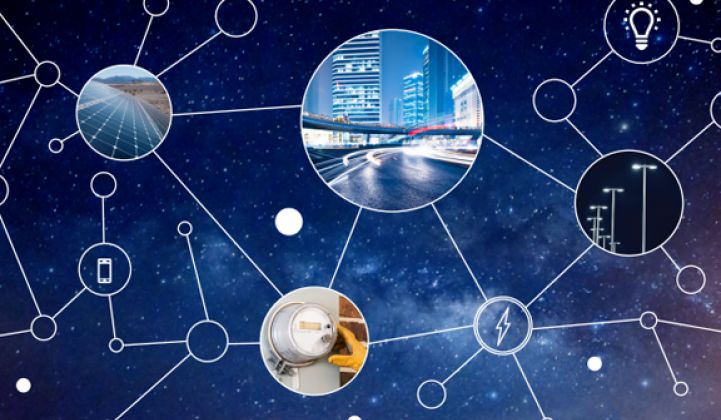It’s been a busy year for Silver Spring Networks, the smart meter networking company that’s seeking to expand its software-as-a-service and internet-of-things business lines. On Tuesday, the company reported fourth-quarter and fiscal year 2016 earnings showed these lines of business are growing, even as large-scale advanced metering infrastructure (AMI) deployments continue to drive its bottom line.
CEO Mike Bell noted a couple of last year’s milestones during Tuesday’s conference call. The company hit record bookings this year, with huge projects like its 5.2-million-meter deployment with Con Edison, a 2.8-million-customer rollout with Entergy, and a 600,000-meter rollout with Pacific Power.
Silver Spring generated $20.7 million in operating cash flows for the year, and finished the year with more than 25.5 million cumulative network endpoints delivered, up from 22.9 million endpoints at the end of 2015. The company’s backlog stood at $1.165 billion at the end of the year, up more than 50 percent from $770 million as of the end of 2015.
Even so, Silver Spring’s 2016 didn’t shine compared to 2015 when measured in GAAP accounting terms. Revenues were down to $311 million, compared to $489 million in the previous year, for a 2016 loss of $21.6 million, compared to a profit of $79.9 million in the previous year. Cost of revenue last year was $37.8 million, or 57.1 percent, compared to $97.9 million or 49.1 percent in 2015, and operating expenses were $41.9 million, compared to $35.6 million in 2015.
Silver Spring’s non-GAAP figures, which it says better represent its financials with utility contracts that tend to see a long lag between delivery and revenues, painted a rosier picture. Its 2016 billings, equivalent to “amounts invoiced for products for which ownership…has transferred or services that have been provided to the customer, and for which payment is expected to be made in accordance with normal payment terms,” stood at $294.6 million, up 4 percent from the previous year.
Cost of billings in 2016 was $39.0 million or 50.2 percent, versus $39.6 million or 52.9 percent in the previous year, and non-GAAP operating expenses were $35.3 million, versus $27.4 million in the previous year. Silver Spring was also prompted by SEC guidance to change some of its non-GAAP metrics compared to previous years, as it laid out in a presentation earlier this month. Silver Spring shares rose to a year-to-date high of $14.04 in late Tuesday trading,
Looking at specific lines of business, interim CFO Kenneth Gianella noted that 2016 product billings, representing the company's core AMI business, rose only 2 percent year-over-year to reach $189.3 million. But 2016 service billings of $105.3 million were up 9 percent from the previous year, and managed service and SaaS billings were $60.5 million, up 16 percent year-over-year. And while international business still represents less than one-fifth of Silver Spring’s billings, that figure was up 20 percent year-over-year.
Silver Spring also chose Tuesday to announce a big expansion to its work with AEP Ohio, which recently won regulator approval for a multifaceted smart grid deployment that includes smart meters for about 900,000 customers across its territory, up from about 110,000 in its first phase. That project is set to start in mid-2017.
On the international front, Silver Spring also announced an expansion of its long-running work with CESC Limited of India to about 237,000 homes and businesses in the cities of Kota and Bharatpur. That’s up from the 25,000 homes first announced in late 2015, and includes 10 years of providing SSN’s Operations Optimizer through a SaaS model, with deployment set to start in the first quarter.
Another new international customer is Dubai Electricity and Water Authority, which will deploy the company’s IOT network canopy across the Emirate of Dubai to connect energy and water, as well as “additional services in the future” for the 700,000-customer utility. Existing customers like Brazil’s CPFL and Baltimore Gas & Electric also expanded their use of Silver Spring’s wireless network for distribution automation, Bell noted.
Moving beyond the grid and into the world of connected things, Bell highlighted how Silver Spring’s Gen5 platform, which offers throughput speeds of 2.4 megabits per second and a tenfold increase in processing power compared to previous iterations of its technology, is supporting “a range of new IOT applications, through our utility customer footprint, or through our Starfish network-as-a-service offering.”
The company announced some new projects at last month’s DistribuTech conference, including a big smart streetlight rollout with existing utility partner Oklahoma Gas & Electric, updates on its smart campus development with IOT partner Ameresco, and progress on citywide IOT networks in U.K. cities, including Bristol and Glasgow.
Silver Spring and U.S.-based competitor Itron have been working for years on expanding the use cases for their smart meter networks, and more recently, pushing into non-utility settings such as streetlights and smart cities. “We have a number of development projects, proof-of-concepts and pilot programs in various stages, including water, environmental monitoring, distributed energy, and other utility applications,” Bell said.
At the same time, “We continue to see additional opportunity to expand our smart grid footprint in the U.S.,” he said. About half of the 150 million endpoints in the U.S. have been contracted for AMI deployments to date, with Silver Spring winning about 36 percent of them. That leaves about half the country as potential customers, including utilities that deployed last-generation automated meter reading technologies about a decade ago, which will “soon be up for refresh,” he said.
Looking ahead, Gianella said Silver Spring’s 2017 outlook includes GAAP revenue of approximately $400 million to $420 million, and non-GAAP billings of approximately $300 million to $320 million. That projection is based on expectations of “double-digit growth of our managed services and SaaS business,” along with several new AMI, street light and DA awards, and “contribution from IOT and new vertical initiatives.”



